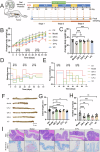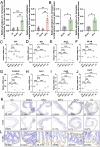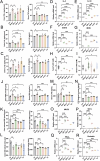A probiotic Limosilactobacillus fermentum GR-3 mitigates colitis-associated tumorigenesis in mice via modulating gut microbiome
- PMID: 39242568
- PMCID: PMC11379937
- DOI: 10.1038/s41538-024-00307-5
A probiotic Limosilactobacillus fermentum GR-3 mitigates colitis-associated tumorigenesis in mice via modulating gut microbiome
Abstract
Bacterial therapy for colorectal cancer (CRC) represents a burgeoning frontier. The probiotic Limosilactobacillus fermentum GR-3, derived from traditional food "Jiangshui", exhibited superior antioxidant capacity by producing indole derivatives ICA and IPA. In an AOM/DSS-induced CRC mouse model, GR-3 treatment alleviated weight loss, colon shortening, rectal bleeding and intestinal barrier disruption by reducing oxidative stress and inflammation. GR-3 colonization in distant colon induced apoptosis and reduced tumor incidence by 51.2%, outperforming the control strain and vitamin C. The beneficial effect of GR-3 on CRC was associated with gut microbiome modulation, increasing SCFA producer Lachnospiraceae NK4A136 group and suppressing pro-inflammatory strain Bacteroides. Metagenomic and metabolic analyses revealed that GR-3 intervention upregulated antioxidant genes (xseA, ALDH) and butyrate synthesis gene (bcd), while increasing beneficial metabolites (SCFAs, ICA, IPA, VB12 and VD3) and reducing harmful secondary bile acids. Overall, GR-3 emerges as a promising candidate in CRC therapy, offering effective gut microbiome remediation.
© 2024. The Author(s).
Conflict of interest statement
The authors declare no competing interests.
Figures







Similar articles
-
Feed-additive Limosilactobacillus fermentum GR-3 reduces arsenic accumulation in Procambarus clarkii.Ecotoxicol Environ Saf. 2022 Feb;231:113216. doi: 10.1016/j.ecoenv.2022.113216. Epub 2022 Jan 19. Ecotoxicol Environ Saf. 2022. PMID: 35065503
-
Role of Dietary Defatted Rice Bran in the Modulation of Gut Microbiota in AOM/DSS-Induced Colitis-Associated Colorectal Cancer Rat Model.Nutrients. 2023 Mar 22;15(6):1528. doi: 10.3390/nu15061528. Nutrients. 2023. PMID: 36986258 Free PMC article.
-
Polysaccharides from Lachnum sp. Inhibited colitis-associated colon tumorigenesis in mice by modulating fecal microbiota and metabolites.Int Immunopharmacol. 2022 Jul;108:108656. doi: 10.1016/j.intimp.2022.108656. Epub 2022 Apr 4. Int Immunopharmacol. 2022. PMID: 35390743
-
Role of SCFAs in gut microbiome and glycolysis for colorectal cancer therapy.J Cell Physiol. 2019 Aug;234(10):17023-17049. doi: 10.1002/jcp.28436. Epub 2019 Mar 19. J Cell Physiol. 2019. PMID: 30888065 Review.
-
Limosilactobacillus fermentum, Current Evidence on the Antioxidant Properties and Opportunities to be Exploited as a Probiotic Microorganism.Probiotics Antimicrob Proteins. 2022 Oct;14(5):960-979. doi: 10.1007/s12602-022-09943-3. Epub 2022 Apr 25. Probiotics Antimicrob Proteins. 2022. PMID: 35467236 Review.
Cited by
-
Neferine Ameliorates Severe Acute Pancreatitis-Associated Intestinal Injury by Promoting NRF2-mediated Ferroptosis.Int J Biol Sci. 2025 Apr 28;21(7):3247-3261. doi: 10.7150/ijbs.112888. eCollection 2025. Int J Biol Sci. 2025. PMID: 40384872 Free PMC article.
-
Pediococcus acidilactici GR-5 alleviates hyperuricemia by degrading purine nucleosides and improving gut microbiota metabolism.NPJ Sci Food. 2025 Aug 23;9(1):183. doi: 10.1038/s41538-025-00556-y. NPJ Sci Food. 2025. PMID: 40849527 Free PMC article.
-
Lacticaseibacillus casei JS-2 from 'Jiangshui' Reduces Uric Acid and Modulates Gut Microbiota in Hyperuricemia.Foods. 2025 Jan 26;14(3):407. doi: 10.3390/foods14030407. Foods. 2025. PMID: 39942000 Free PMC article.
-
Molecular Mechanisms of Probiotic Action Against Gastrointestinal Cancers.Int J Mol Sci. 2025 Aug 14;26(16):7857. doi: 10.3390/ijms26167857. Int J Mol Sci. 2025. PMID: 40869174 Free PMC article. Review.
References
-
- Patel, S. G., Karlitz, J. J., Yen, T., Lieu, C. H. & Boland, C. R. The rising tide of early-onset colorectal cancer: a comprehensive review of epidemiology, clinical features, biology, risk factors, prevention, and early detection. Lancet Gastroenterol. Hepatol.7, 262–274 (2022). 10.1016/S2468-1253(21)00426-X - DOI - PubMed
Grants and funding
LinkOut - more resources
Full Text Sources
Miscellaneous

